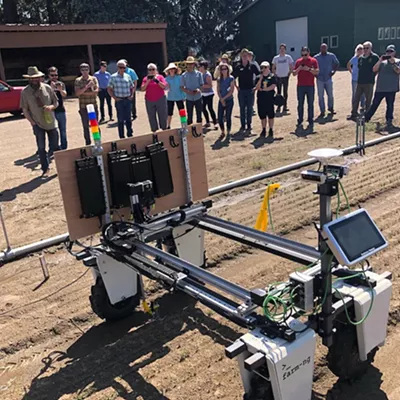t first glance, it looked like the remains of a weekend clambake. But the well-charred piles of freshwater clam shells hadn't been made last month or last year. Instead, these mussel shells — uncovered by the city of Spokane's archaeological explorations at the mouth of Hangman Creek in Peaceful Valley last summer — were thousands of years old. Although not many people think of eating them now, mussel shells gathered, processed and then discarded by humans appear in many archaeological digs on the Columbia Plateau. The life of these mollusks has been intimately connected to communities here for as long as salmon, deer or camas.
Freshwater mussels have a worldwide distribution; more than 200 species occur in North America, and a couple of dozen in the Columbia River drainage alone. Prehistoric groups gathered only three kinds, and the most widespread of these goes by the mellifluous Latin name of Margaritifera falcata. Once they're pried opened, Margaritiferas are beautiful to look at — the nacre, or iridescent interior layer of the shell, shows hues ranging from salmon pink to royal purple, and the colors serve as an identifying trait.
The life history of Margaritifera plays out in stages, beginning in the four gills that filter particulates from passing water. Adult females use spaces within these gills as marsupia, or brood pouches, to harbor their embryos. Like many mollusks, Margaritifera are remarkably fecund: One female can brood more than a million embryos at a time. When the water temperature of their native river reaches a certain level, usually in late summer, a female poofs out her entire cloud of embryos in a minute or two, dispatching them to the next stage of their journey.
The baby mussels drift through the water as tiny parasites, searching for a host. Less than 1 percent of them happen upon a suitable species of fish — usually salmon, steelhead, or trout — and attach themselves to the interior of the gills via their half-dozen little teeth. Once secure, they immediately encase themselves in a protective cyst and begin to absorb nutrients from the host fish. Over the next few weeks, the hitchhikers may increase in size up to 500 times before dropping away to drift once again, this time to the bottom. Only those that land on a stable bed of gravel stand a chance of surviving.
On the river bottom, each mussel produces a byssus thread and attaches itself to a stone, then burrows into the substrate. They remain semi-buried, rear end up, filtering water through their gills for food, over the next decade or so. When they approach the length of a finger segment, they detach their anchoring thread and become mobile again. In this adult stage they continue to grow and finally begin to breed.
Given the right conditions, a single Margaritifera might reach a length of five inches, live for 130 years, and produce more than 200 million embryos. Our local mussels prefer fast-moving current and cold water, with concentrated "beds" found in sand and gravel just downstream from protective boulders. One population in the Kettle River was estimated at several thousand individuals in an area of 150 square yards.
This kind of abundance practically ensures that there would be some interaction between people and freshwater mussels; indeed, archaeologists have long recognized and debated human-deposited shell heaps or "middens." On the Columbia Plateau, researchers recognize shell middens that range from a single-family meal to long-term deposition by a village. These middens appear in the archaeological record from 9,000 years ago, but show a marked increase beginning around 5,000 years ago. Freshwater mussels and their shells were used for food, bait, spoons, ear ornaments, house floors or fill, walls, and fire pits; the most common occurrence is of a pile of discarded matched shell halves mixed with fire-cracked rock, lesser amounts of animal and fish bones, and large striking tools nearby — exactly the kind of footprint uncovered at the mouth of Hangman Creek.
For most of the 20th century, anthropologists interpreted Plateau tribal accounts of mussel use to mean that the mollusks were nothing more than "starvation food," a resource to be used only during hard times or difficult seasons of the year. Relatively few mentions of collection techniques led to the assumption that most of the gathering was done by women and children wading during low water. Mussels were prepared by boiling them in baskets with hot rocks or roasting them in underground ovens; if not consumed immediately, the meat of the mussels was dried and strung on cords or sticks for the long term.
Becky Stevens of Archaeological and Historical Services at Eastern Washington University wrote her master's thesis at EWU on the remains of Margaritifera shells found at Plateau archaeological sites. She analyzed the calories, protein and other nutrients in Margaritaferas and agreed with earlier archeologists' findings that the mussels could not have played a large role in any regular diet.
But Stevens also found that Margaritiferas are extremely rich in calcium and iron, two minerals of key importance to pregnant and lactating women. Today, most mothers get these minerals from dairy products or supplemental pills, products not available to Plateau women in times past. It takes less than a dozen freshwater mussels to satisfy the USDA minimum daily requirement for iron for a family of five, and only a few dozen to do the same for calcium. With the mussels so abundant and easy to gather in local rivers, this means that even small children could have brought home enough to meet their family's — and especially their mother's — requirements.
The people of the Plateau had a very specific need, and somehow they knew that Margaritifera could supply it. For members of a certain village along the Spokane River, that need could be met simply by taking a pleasant wade in the creek below the big falls.
Jack Nisbet is the Spokane author of The Mapmaker's Eye: David Thompson on the Columbia Plateau.




















